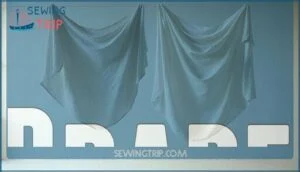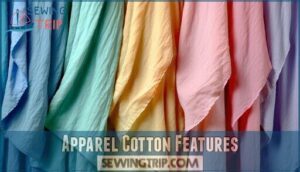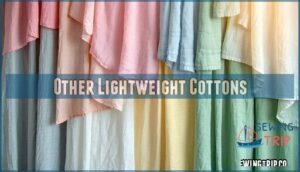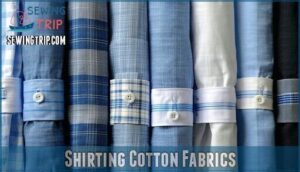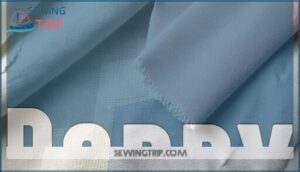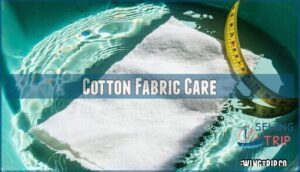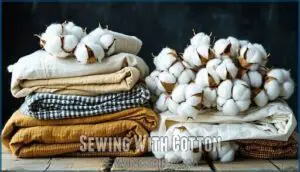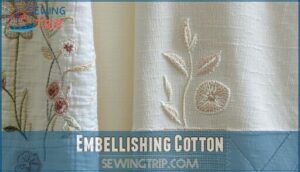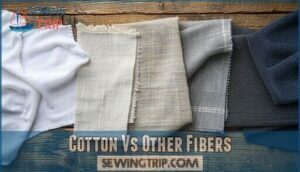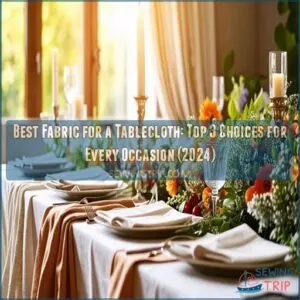This site is supported by our readers. We may earn a commission, at no cost to you, if you purchase through links.
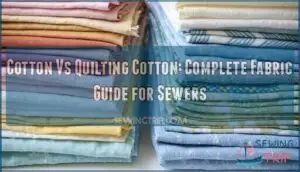 When you’re comparing cotton vs quilting cotton, think of it like comparing a reliable sedan to a sports car built for precision.
When you’re comparing cotton vs quilting cotton, think of it like comparing a reliable sedan to a sports car built for precision.
Regular cotton comes in various weights and weaves for general sewing projects.
Quilting cotton, however, is engineered specifically for quilters’ needs.
It features a tighter weave that prevents fraying, consistent medium weight around 4-5 ounces per square yard, and minimal stretch that keeps your quilt blocks perfectly aligned.
The premium construction means quilting cotton costs more but delivers superior results for piecing and appliqué work.
Understanding these key differences will transform how you choose fabrics for every project.
Table Of Contents
Key Takeaways
- You’ll find quilting cotton has a tighter weave and higher thread count (68-78 threads per inch) compared to regular cotton, making it stiffer and more structured for precise piecing work that won’t stretch or distort during construction.
- Regular cotton works better for clothing projects since it offers softer drape and natural movement, while quilting cotton’s structured feel creates boxy, restrictive garments that lack the flowing qualities you want in apparel.
- You should expect to pay more for quilting cotton due to its premium construction, but this investment delivers superior durability and longevity for quilts that’ll last generations through countless washes.
- Both fabric types require prewashing to prevent shrinkage surprises, but quilting cotton typically shrinks 3-5% while regular cotton can shrink up to 10% without proper care using cold water and gentle cycles.
Cotton Fabric Types
When choosing cotton fabric, you’ll encounter various cotton types with distinct properties.
Cotton weaves range from plain to complex patterns, while fiber length affects durability and softness.
From basic plains to intricate patterns, every cotton weave tells its own story of texture and purpose.
Organic cotton offers chemical-free options, and cotton blends combine different fibers for enhanced performance.
Fabric weight varies from lightweight lawn to medium-weight quilting cotton.
Each cotton type serves specific purposes – quilting cotton provides structure for piecing, while apparel cotton offers drape for clothing.
Understanding these cotton properties helps you make informed fabric comparisons for your sewing projects.
Quilting Cotton Features
Quilting cotton stands apart from regular cotton with its tighter weave and higher thread count, typically 68-78 threads per inch compared to standard cotton’s looser construction.
You’ll notice its stiffer drape and medium weight make it perfect for structured projects like quilts, where precise piecing and durability matter more than the flowing movement you’d want in clothing.
Weight
Substance matters when you’re choosing between regular cotton and quilting cotton.
Weight directly impacts your project’s success, and here’s what you need to know:
- Quilting Weight: Ranges from 140-190 GSM, providing structure for piecing
- Apparel Weight: Lighter at 110-130 GSM, offering better drape for clothing
- GSM Explained: Grams per square meter measure fabric density accurately
- Weight Impact: Heavier cottons create sturdier quilts, lighter ones flow naturally
Quilting cotton’s extra heft comes from its tighter weave and higher thread count.
You can find more information regarding specific cotton weights.
This fabric density prevents stretching during construction while regular cotton weight prioritizes comfort and movement for garments.
Drape
Most quilting cotton stands apart from regular cotton fabric with its distinctly stiffer drape.
This fabric stiffness creates the structured foundation that makes quilting possible. Unlike apparel cotton that flows and moves with your body, quilting fabric holds its shape with authority.
The drape comparison between these cotton types is striking:
- Quilting Structure: Maintains crisp edges and sharp points
- Fabric Stiffness: Resists stretching during piecing and sewing
- Cotton Blends: Won’t distort under tension like softer fabrics
This structured behavior isn’t a flaw—it’s exactly what you want for precise patchwork. While clothing applications might call for flowing drape, quilting cotton’s firm character guarantees your blocks stay square and your seams lie flat.
Uses
When you’re ready to tackle your next project, quilting cotton delivers impressive versatility that extends far beyond traditional quilts.
This cotton fabric excels in craft projects like tote bags, placemats, and pillow covers where structure matters.
You’ll find quilting fabric perfect for home decor items including curtains, table runners, and wall hangings.
While clothing applications work best for structured garments like aprons or pajamas, the stiff drape isn’t ideal for flowing dresses.
The tight weave guarantees quilt longevity, making heirloom pieces that last generations.
Cotton uses span from beginner-friendly crafts to complex quilting masterpieces.
Apparel Cotton Features
Unlike quilting cotton’s structured feel, apparel cotton fabric flows like water against your skin.
Cotton whispers against fabric while quilting cotton stands at attention—each serving its perfect purpose.
You’ll notice the drape and flow immediately when you hold it up – it moves gracefully rather than standing stiff.
This cotton fabric comes in weave variations that create different textures, from smooth poplin to slightly textured broadcloths.
The lighter weight makes it perfect for clothing items like blouses, sundresses, and casual shirts.
You’ll love how breathable it feels during summer months.
Print durability varies between manufacturers, but quality apparel cottons hold their patterns well through multiple washes.
Color retention depends on the fiber quality and dyeing process.
Comfort factors include moisture-wicking properties and softness against skin.
These fabric uses extend beyond basic garments to pajamas and lightweight jackets.
When shopping for cotton types, check the width – apparel cotton typically comes 60 inches wide versus quilting cotton’s standard 45 inches.
Other Lightweight Cottons
You’ll find several lightweight cotton fabrics that offer different textures and weights compared to standard quilting cotton, each serving specific sewing purposes.
These fabrics include lawn, poplin, and voile, which range from 70-130 GSM and provide options from smooth and semi-transparent to crisp and structured finishes, making them suitable for various sewing projects.
Lawn
Cotton lawn stands apart from sturdy quilting cotton with its whisper-thin construction and semi-transparent quality.
You’ll find this delicate fabric weighs just 70-100 grams per square meter, making it perfect for flowing summer garments where breathability matters most.
Lawn characteristics include its smooth texture and fine thread count that creates an almost ethereal feel.
When sewing lawn, you’ll appreciate how it drapes gracefully without the stiffness of quilting cotton used for quilts.
Key lawn uses include:
- Romantic blouses and flowing dresses
- Delicate lingerie and sleepwear
- Lightweight curtains and window treatments
- Foundation layers for embellishment projects
Poplin
Looking beyond lawn’s delicate nature, poplin brings more structure to your sewing basket.
This cotton fabric features a distinctive ribbed texture from its tightly woven plain weave. Poplin characteristics include medium weight and crisp hand, making it perfect for button-down shirts and structured garments.
Its poplin durability surpasses many lightweight cottons, though it’s still easier to handle than quilting cotton.
Poplin applications span from professional blouses to casual wear. When sewing poplin, you’ll appreciate its stability and clean finish potential.
Voile
You’ll find voile offers a different experience from poplin’s crispness.
This sheer cotton fabric drapes beautifully with remarkable transparency that makes it perfect for layering projects.
Voile’s delicate weave creates flowing garments like scarves and curtains, though its sheerness limits durability compared to quilting cotton.
While voile costs more than regular cotton fabric, its graceful draping and lightweight feel make it ideal for summer clothing and decorative quilting applications requiring elegant movement and a perfect choice for projects needing remarkable transparency.
Shirting Cotton Fabrics
You’ll find shirting cottons offer the perfect balance between durability and comfort for your button-up projects.
These medium-weight fabrics, including Oxford and chambray, give you that crisp structure that holds its shape through countless wears and washes.
Oxford
With its distinctive basketweave pattern, Oxford shirting stands out as the workhorse of cotton fabrics.
You’ll immediately recognize Oxford’s signature crisscross texture that creates those tiny squares across the surface.
This Oxford weave technique interlaces heavier warp threads with finer weft threads, delivering exceptional Oxford durability that’s lasted over 150 years in fashion history.
The open Oxford texture allows excellent breathability while maintaining structure for crisp collars and cuffs.
Traditional Oxford shirting uses medium-weight cotton yarns, though modern variations include pinpoint Oxford with tighter weaves and royal Oxford featuring colored warps.
This reliable quilting cotton alternative excels in button-down shirts where longevity matters most.
Chambray
Unlike Oxford’s basketweave structure, chambray fabric offers exceptional softness through its plain weave construction.
You’ll love how the colored warp threads paired with white weft create that signature denim-like appearance without the stiffness.
Here’s what makes chambray shine for summer sewing:
- Chambray Weight – Lightweight feel perfect for breezy garments
- Chambray Softness – Gentle against skin, ideal for shirts
- Chambray Durability – Withstands regular washing better than quilting cotton
- Chambray Weave – Plain weave provides excellent drape
- Chambray Versatility – Works for both casual and dressy projects
Unique Cotton Weaves
You’ll encounter several unique cotton weaves that differ from standard plain weave fabrics, each offering distinct textures and performance characteristics.
These specialty weaves—including sateen‘s lustrous finish, dobby’s raised patterns, and twill’s diagonal ribbing—create fabrics with enhanced drape, durability, or visual appeal for specific sewing projects.
Sateen
Beyond basic shirting fabrics, sateen fabric offers a premium cotton experience that’ll transform your sewing projects.
This sateen weave creates that coveted sateen sheen through a four-over-one-under pattern, giving cotton fabric an almost silk-like appearance. You’ll love how it drapes compared to regular quilting cotton.
Here’s what makes sateen special:
- Luxurious surface that catches light beautifully
- Wrinkle-resistant finish that stays crisp longer
- Dense weave that provides excellent sateen durability
- Smooth texture that’s perfect for fine garments
While sateen cost runs higher than basic cotton, its sateen applications include elegant blouses, flowing skirts, and premium bedding that rivals quilting projects.
Dobby
Dobby cotton showcases raised geometric patterns created through specialized dobby loom mechanics that lift specific warp threads.
You’ll recognize dobby weave characteristics by their textured dots, stripes, or small motifs woven directly into the fabric.
Unlike quilting cotton’s plain weave, dobby offers visual depth perfect for blouses and home décor.
Dobby fabric uses extend beyond clothing to curtains and table linens.
While dobby vs jacquard comparisons arise, dobby creates simpler patterns with fewer harnesses.
Dobby cotton blends maintain the cotton’s breathability while adding structural interest to your sewing projects.
Twill
When you’re choosing cotton fabric for structured garments, twill’s diagonal rib pattern delivers exceptional durability and visual appeal.
This twill weave structure creates a textured surface that resists wrinkles better than plain cotton.
Here’s why twill fabric works perfectly for your projects:
- Superior drape properties – maintains shape without stiffness
- Enhanced durability factors – tight weave withstands frequent wear
- Versatile fabric weight – ideal for pants, jackets, and skirts
- Simple washing methods – less prone to wrinkles than quilting cotton
Cotton Fabric Care
You’ll need to prewash your cotton fabrics before cutting to prevent unwanted surprises after your project’s complete.
Cotton can shrink up to 3% during its first wash, which means that perfect quilt or garment could end up with puckered seams and distorted measurements if you skip this essential step.
Prewashing
Cotton fabric transforms from potential problem child to reliable partner through proper preshrinking and prewashing.
You’ll discover significant preshwash benefits by washing your quilting cotton before cutting.
Start with lukewarm water temperature – not scalding hot, not ice cold. Your detergent choice matters: skip fabric softeners that can leave residue and opt for gentle, fragrance-free options.
Machine wash on a delicate cycle, then choose air-drying methods over high heat. This process removes manufacturing chemicals and excess dyes while controlling initial fabric shrinkage.
Think of prewashing as your fabric’s dress rehearsal before the main performance.
Shrinkage
Understanding fabric shrinkage helps you avoid sizing surprises after your first wash.
Quilting cotton typically shrinks 3-5%, while regular cotton can shrink up to 10% without proper care.
Pre-wash benefits include removing chemicals and preventing future shrinkage in finished projects.
Temperature effects play a vital role – hot water and high dryer heat increase shrinkage percentage substantially.
Washing methods matter too.
Use cold water and gentle cycles for best results.
Air drying eliminates heat-induced shrinkage entirely.
For softening methods, try fabric softener or vinegar solutions to tame stiff quilting cotton without compromising its structure.
Sewing With Cotton
You’ll find that cotton fabric choices directly affect your sewing results, whether you’re crafting a summer dress or piecing together a patchwork quilt.
Your project’s success depends on matching the right cotton type to your intended use, since quilting cotton‘s stiff structure works perfectly for precise piecing but won’t give you the flowing drape needed for clothing, which requires a different type of cotton for the best sewing results.
Making Clothes
Your fabric choice makes or breaks your handmade wardrobe. When selecting cotton for clothing items, skip quilting cotton despite its appealing prints. Its stiff structure creates drape concerns that’ll leave your dresses looking boxy rather than flowing.
Instead, reach for proper apparel cotton designed for dressmaking. These fabrics offer superior clothing comfort and natural movement.
Quilting cotton’s dense weave means garment durability isn’t an issue, but style limitations definitely are. You’ll need pattern adjustments to accommodate the extra bulk, and fitted garments will feel restrictive.
Save quilting cotton for crafts and choose lightweight cotton varieties that move with your body for truly wearable results. For breathable summer clothes, consider various cotton options.
Making Quilts
While clothing calls for drape and flow, quilts demand structure and staying power.
Quilting cotton’s higher thread count and medium weight create the perfect foundation for your quilting projects. This quilting fabric holds its shape through countless washes, ensuring quilt durability that lasts generations.
Here’s your roadmap to quilting success:
- Pre-washing removes shrinkage and chemicals before cutting
- Choose quality batting that matches your cotton weight
- Press seams flat to eliminate bulk and puckers
- Pin matching points carefully before stitching pieces together
- Consider fabric softeners if your quilting cotton feels too stiff
Smart fabric choices transform ordinary quilts into cherished heirloom pieces. Many sewers find prewashing cotton fabrics beneficial.
Embellishing Cotton
You’ll find that both regular cotton and quilting cotton work well for embellishment techniques, though each offers distinct advantages depending on your project.
Regular cotton’s softer drape makes it ideal for clothing embroidery, while quilting cotton’s stable weave provides the perfect foundation for appliqué work and detailed stitching, showcasing the distinct advantages of each type of cotton.
Embroidery
Transforming plain cotton fabric into stunning artwork happens when you add embroidery details. Cotton fabric and quilting cotton both work beautifully for embroidery projects because their tight weave holds stitches securely.
You’ll need quality embroidery floss, appropriate needle types for different thread weights, and basic stitch techniques like backstitch and French knots.
Pattern transfer methods include iron-on designs or water-soluble markers for custom work. Stabilizers prevent puckering when machine embroidering on lighter cotton fabrics.
Hand embroidery creates charming vintage appeal on quilting projects, while machine embroidery adds professional finishing touches to clothing. Start with simple designs before tackling complex patterns.
The structured nature of quilting cotton makes it perfect for detailed sewing work that requires precision stitching.
Applique
Beyond basic embroidery stitches, applique techniques transform your quilting cotton into dimensional artwork.
You’ll cut fabric shapes and attach them to base fabric, creating layered designs that pop.
Fabric selection matters—choose quilting cotton for durability or lightweight cottons for delicate details.
Design considerations include color contrast and motif placement.
Raw-edge applique lets fabric fray naturally for rustic charm, while turned-edge applique creates crisp, finished looks.
Stitch types range from hand blanket stitches to machine zigzag or satin stitching.
Project ideas include decorative quilts, personalized clothing, or home décor items.
Your quilting projects gain personality through thoughtful applique placement and dimensional artwork.
Cotton Vs Other Fibers
When you’re choosing fabric, cotton isn’t your only option – linen, wool, and knits each offer different benefits for your sewing projects.
Understanding how cotton compares to these other fibers helps you pick the right material for your specific needs and desired finished look, and this comparison is key to achieving your desired finished look.
Linen
When you’re choosing between cotton and linen for your quilts, understanding their key differences helps you make the right call.
Linen origins trace back to flax plants, creating a fabric that’s approximately 30% stronger than cotton.
This linen durability makes it excellent for structured projects, though it comes with trade-offs. Linen weaves create beautiful texture, but linen cost runs higher than quilting cotton.
Here’s how cotton and linen compare for quilting:
| Feature | Cotton | Linen |
|---|---|---|
| Breathability | Good | Excellent |
| Wrinkle Resistance | Better | Poor |
| Softness | Softer | Stiffer initially |
| Cost | Lower | Higher |
While linen blends offer compromise solutions, pure cotton remains the go-to choice for most quilting projects due to its manageable care requirements and consistent behavior. The choice between cotton and linen ultimately depends on the quilting project’s specific needs, considering factors like breathability, wrinkle resistance, and cost.
Wool
Unlike linen’s plant-based origins, wool comes from sheep and other animals, creating a completely different fabric experience. When you’re comparing cotton fabric options for your quilting projects, understanding wool’s unique properties helps you make better choices.
Wool’s natural crimp gives it incredible elasticity and insulation. You’ll find it keeps you warm even when damp, unlike cotton that loses warmth when wet. The fiber’s structure creates air pockets that trap heat effectively.
| Property | Cotton | Wool |
|---|---|---|
| Breathability | High | Medium |
| Warmth | Low | High |
| Care | Easy | Delicate |
| Durability | Good | Excellent |
| Cost | Lower | Higher |
While quilting cotton works beautifully for quilts, wool blends offer different advantages for clothing projects. Wool’s natural elasticity makes garments more forgiving, though it requires gentler care than your typical cotton fabric. This is due to its unique properties, which include natural crimp, making it a valuable choice for certain projects, especially those requiring durability and warmth.
Knits
Cotton and quilting cotton can’t match knits when you need stretch and comfort. Knit fabric types offer flexibility that woven cottons simply don’t provide.
Your knit garments move with you, while cotton stays rigid.
| Knit Type | Stretch Level | Best Knit Projects |
|---|---|---|
| Jersey | High | T-shirts, leggings |
| Ribbing | Maximum | Cuffs, neckbands |
| Interlock | Medium | Baby clothes, pajamas |
| French Terry | Low | Sweatshirts, robes |
Knit drape flows naturally, creating comfortable clothing that breathes with your body’s movement.
Frequently Asked Questions (FAQs)
What is the difference between woven cotton and quilting cotton?
Like comparing a sturdy work shirt to delicate pajamas, woven cotton refers to any cotton fabric made by interlacing threads.
While quilting cotton‘s specifically designed with tighter weaves and higher thread counts for durability.
How is Quilter’s cotton different from other types of cotton?
You’ll find quilter’s cotton has a tighter weave and higher thread count than regular cotton, making it stiffer and more structured.
It’s designed specifically for quilting projects, offering better durability and precise piecing capabilities.
What is the difference between quilting cotton and plain cotton?
You’ll notice quilting cotton has a tighter weave and higher thread count than regular cotton.
It’s stiffer, less drapey, and built for durability in quilts rather than clothing’s softer, more flexible needs.
Why is cotton a good fabric for a quilt?
Unlike synthetic materials that trap heat, cotton’s natural fibers breathe beautifully.
You’ll love how it absorbs moisture, maintains comfortable temperatures, and creates durable quilts that soften with each wash while preserving their structural integrity, making it a great choice due to its ability to breathe beautifully.
Is quilting cotton better than regular cotton?
Quilting cotton’s tighter weave and higher thread count make it superior for quilts, offering better durability and structure.
However, regular cotton works better for clothing since it’s softer and drapes more naturally.
What is the difference between quilting cotton and regular cotton?
Regular cotton comes in various weights and weaves for different uses.
While quilting cotton features a tighter weave, higher thread count, and stiffer drape that’s specifically designed for piecing quilts together precisely.
Can I use quilting cotton to make clothes?
You can definitely use quilting cotton for clothes, but it’ll feel stiffer than regular cotton.
It works great for structured garments like button-ups or pajamas, though it won’t drape as softly.
Is quilting cotton durable?
Absolutely rock-solid! You’ll find quilting cotton’s tight weave and higher thread count create fabric that’ll outlast your favorite jeans.
It resists fraying, shrinking, and stretching, making it perfect for projects you’ll treasure for years, with a durability that is truly rock-solid.
Can you use quilting cotton for pajamas?
Yes, you can absolutely use quilting cotton for pajamas.
It’s soft, breathable, and provides comfortable warmth for sleeping.
The medium weight and crisp finish make cozy sleepwear that’ll last through countless washes.
What are the key differences between cotton and quilting cotton?
The devil’s in the details when comparing fabrics.
Quilting cotton has a tighter weave and higher thread count than regular cotton, making it stiffer and more structured for precise piecing work.
Conclusion
While some sewers think any cotton fabric works for quilting, choosing the right type makes all the difference in your finished project.
Understanding cotton vs quilting cotton guarantees you’ll select fabrics that match your specific needs.
Quilting cotton’s stable weave and consistent weight deliver precision for patchwork, while apparel cottons offer drape and comfort for garments.
You’ll save time, reduce frustration, and create better results when you match fabric properties to your project requirements.


